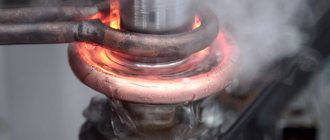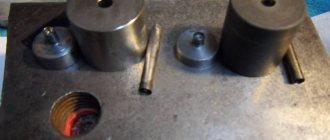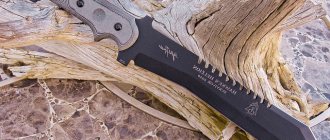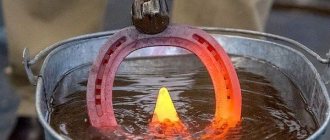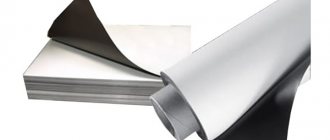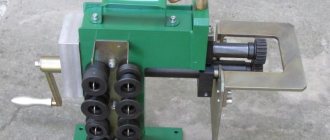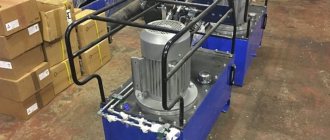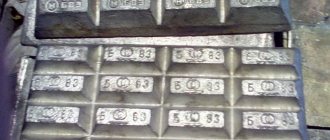What is surface hardening
The technology is based on heating a steel billet to a temperature that exceeds a critical level, followed by cooling. Each stage of heat treatment is carried out quickly, so only the outer layers of the product are exposed.
The austenite grain does not have time to grow during this time. This allows you to avoid loss of ductility of the steel alloy, reduce the threshold of its cold brittleness and tendency to fracture. The result is an increase in the endurance limit, hardness, and wear resistance of the structure while maintaining the plasticity of its core.
The need for surface hardening and tempering
Recrystallization of the metal occurs when it is heated with a critical temperature level exceeded by 30-50 ° C and further cooled after a sufficient period of time. It solves the problem of preventing the transformation of austenite into pearlite. A special feature of a steel part after hardening is its non-equilibrium structure.
Recrystallization of the metal occurs after sufficient time.
To soften this effect, relieve residual stresses, and reduce brittleness, the metal is released, reheating it to a temperature that does not reach a critical point. This way it is possible to achieve an optimal combination of strength and ductility. Treatment helps to increase the yield strength, impact strength, relative contraction, and elongation of steel with the same chemical composition and hardness of the workpieces.
Classification of types of heat treatment
To change the properties of the alloy that arise as a result of heat treatment, it is necessary that the remaining changes caused primarily by phase transformations occur in the alloy as a result of heat treatment.
All types of heat treatment can be divided into four main groups.
First group. Previous processing may render the metal unstable. Thus, cold plastic deformation creates hardening—distortion of the crystal lattice. During solidification, diffusion processes do not have time to occur, and the composition of the metal, even within the volume of one grain, turns out to be heterogeneous.
nom. Rapid cooling or uneven application of stress makes the distribution of elastic deformation uneven. The unstable state at room temperature persists for a long time, since the thermal motion of atoms at room temperature is not enough to transition to a stable state.
Heating (increasing the thermal mobility of atoms) leads to the fact that the processes that bring the metal to a stable state (stress relief, reduction of crystal lattice distortions, recrystallization, diffusion) reach noticeable speeds.
Heat treatment, which consists in heating a metal that, as a result of some previous treatment, has received an unstable state, and bringing it to a more stable state, is called annealing.
If a phase transformation occurs in alloys when heated (allotropic transformation, dissolution of the second phase, etc.), then heating above a certain critical temperature causes a change in the structure of the alloy. Upon subsequent cooling, the reverse transformation will occur. If the cooling is sufficiently slow, then the transformation will be complete, and the phase composition will correspond to the equilibrium state.
There are two types of annealing. If the alloy does not have phase transformations, then any heating of an alloy with a nonequilibrium structure brings the alloy into a more equilibrium state. This annealing is called first-order annealing
If an alloy has a phase transformation, then heating an alloy with a nonequilibrium structure (but not caused by quenching) above the temperature of phase transformations, followed by slow cooling, brings the alloy to a more equilibrium state.
This treatment also refers to annealing, but is classified as second-order annealing
or
phase recrystallization.
Second group. If phase changes occur in an alloy during heating, then the completeness of the reverse (during cooling) transformation depends on the cooling rate. Theoretically, one can imagine such cooling conditions under which the reverse transformation will not occur at all, and at room temperature, as a result of rapid cooling, the state of the alloy will be fixed, characteristic of high temperatures. This operation is called hardening.
In many cases, hardening does not completely (or does not completely) fix the state of the alloy, which is stable at high temperatures. Therefore, the limiting case of quenching, when the state of the alloy, characteristic of high
high temperatures, fixed, called true hardening,
in contrast to quenching in a broader sense, when it is not the state of the alloy at high temperature that is fixed, but some stage of its structural transformation, at which an equilibrium state has not yet been achieved in the alloy.
Hardening can be volumetric
(the entire product is heated through for quenching) and
surface
(local, often surface) heating is carried out.
There is something in common between hardening and annealing of the second kind. In both cases, the alloy is heated above the phase transformation temperature, and acquires its final structure as a result of the transformation upon subsequent cooling. However, there is a fundamental difference between both types. During annealing of the second type, the purpose of cooling is to bring the alloy closer to an equilibrium state, so cooling is carried out slowly. During quenching, cooling is rapid in order to distance the structural state of the alloy from equilibrium.
Third group. The state of the hardened alloy is characterized by instability. Even without any temperature influence, processes can occur in the alloy that bring it closer to an equilibrium state. Heating the alloy, which increases the mobility of atoms, promotes these transformations. As the temperature increases, the hardened alloy approaches the equilibrium state more and more. Such processing, i.e. heating of a hardened alloy, but below the temperature of equilibrium phase transformations, is called tempering.
And during first-order annealing, as well as during tempering, the alloy approaches structural equilibrium.
In both cases, the initial stage is characterized by an unstable state; only for first-order annealing it was the result of pre-treatment, during which, however, there were no phase transformations, and for tempering it was the result of previous quenching. Thus, tempering is a secondary operation, always carried out after hardening. Vacation is sometimes called aging.
In some cases, aging is called long-term low-temperature heating, combining annealing of the first kind and tempering; in others, heating of hardened steel is called tempering, and heating of hardened alloys of non-ferrous metals is called aging. The following distinction between tempering and aging is now recommended: tempering is the heating of a hardened alloy that has phase transformations; aging is the heating of a hardened alloy that does not undergo phase transformations. In this case, hardened
the state is characterized by supersaturation of the solid solution. Let us give a brief definition of the main types of heat treatment.
Annealing
- a thermal operation consisting of heating a metal that has an unstable state as a result of previous processing, and bringing the metal into a more stable state.
Hardening
- a thermal operation consisting of heating above the transformation temperature followed by sufficiently rapid cooling to obtain a structurally unstable state of the alloy.
Vacation -
a thermal operation consisting of heating a hardened alloy below the transformation temperature to obtain a more stable structural state of the alloy.
In addition to these main types of heat treatment, there are two more fundamentally different methods, representing a combination of heat treatment with metallurgy or mechanical technology.
The ability of metals to dissolve various elements allows, at elevated temperatures, the atoms of the substance surrounding the surface of the metal to diffuse into it, creating a surface layer of altered composition. This treatment changes not only the composition, but also the structure of the surface layers, and sometimes the core. This treatment is called chemical-thermal treatment
(HTO). This type of chemical-thermal treatment involves a kind of reverse process - the removal of elements by selecting appropriate media. The diffusion mobility of non-metals (C, N, O, H, B) is different from the mobility of metals, therefore chemical-thermal treatment is divided into diffusion saturation with non-metals and metals.
Recently, processing has been used in which deformation and structural transformations are combined in a single technological process. This treatment is called deformation-thermal.
Depending on when plastic deformation occurs before or after transformation, deformation-heat treatment is divided into
thermo-mechanical treatment
of TMT (deformation is carried out before transformation) and
mechanical-thermal treatment
of MTO (deformation is carried out after transformation). Thus, to the three main types of heat treatment (annealing, hardening, tempering), two complex treatments must be added:
chemical-thermal treatment -
heating the alloy in appropriate chemical reagents to change the composition and structure of the surface layers:
deformation-heat treatment -
deformation and subsequent heat treatment, preserving the results of hardening in one form or another.
10.3. Main types of heat treatment of steel
If the basis for studying the heat treatment of alloys is the corresponding phase diagram, then, obviously, the basis for studying the heat treatment of steel is the iron-carbon diagram. Since we are considering the heat treatment of steel, we are only interested in alloys with a concentration of up to 2% C and, accordingly, the area on the iron-carbon diagram with a carbon concentration of up to 2% (more precisely, up to 2.14% C).
Naturally, the upper temperature limit during heat treatment is the solidus line, therefore the processes of primary crystallization and, consequently, the upper part of the diagram are not of great importance for us in this case.
The section of the iron-carbon diagram that we will consider is shown in Fig. 48.
Let us give the generally accepted designations for critical points.
Critical points are designated by the letter A.
Fig.48. “Steel” section of the Fe-C diagram
The lower critical point, designated A1,
lies on the
PSK
and corresponds to the austenite ↔ pearlite transformation.
The upper critical point A3
lies on the
GSE
and corresponds to the beginning of precipitation or the end of dissolution of ferrite in hypoeutectoid steels or cementite (secondary) in hypereutectoid steels.
c
is placed
next to the letter
in the first case and
r
in the second.
Therefore, the critical point of transformation of austenite into pearlite is denoted Ar1,
and pearlite into austenite
Ac1,
the beginning of the separation of ferrite from austenite is designated
Ar3;
end of dissolution of ferrite in austenite
Ac3.
The beginning of the separation of secondary cementite from austenite is also designated
Ar3,
and the end of the dissolution of secondary cementite in austenite is
Ac3
.
Below is a description of the main types of heat treatment of steel in accordance with the above classification.
Annealing -
phase recrystallization, which consists of heating above
Ac3
followed by slow cooling.
When heated above Ac1,
but below
Ac3
, complete recrystallization will not occur;
This heat treatment is called partial annealing.
During annealing, the state of the steel approaches the equilibrium structure; steel structure after annealing: pearlite + ferrite, pearlite or pearlite + cementite.
If after heating above Ac3
cooling in air, this will be the first step towards deviation from the almost equilibrium structural state.
This thermal operation is called normalization
Hardening
- heating above the critical point
Ac3
followed by rapid cooling.
With slow cooling, austenite decomposes into ferrite + cementite at Ar1
.
As the cooling rate increases, the transformation occurs at lower temperatures. Ar1
decreases, the ferrite-cementite mixture becomes increasingly finely dispersed and hard.
If the cooling rate was so high and the overcooling was so significant that the precipitation of cementite and ferrite did not occur, then the decomposition of the solid solution does not occur, and austenite (γ-solid solution) turns into martensite
(a supersaturated solid solution of carbon in α-iron) .
Incomplete hardening is
a thermal operation in which heating is carried out until
temperature lying above Ac1,
but below
Ac3
and in the steel structure, hypoeutectoid ferrite (hypoeutectoid cementite) is preserved.
Vacation
- heating of hardened steel below
Ac1
and subsequent slow cooling.
of chemical-thermal treatment are possible for steel
depending on the element diffusing into the steel.
Saturation of steel with carbon is called carburization,
nitrogen -
nitriding,
aluminum -
aluminizing,
chromium -
chrome plating,
etc.
Thermo-mechanical processing of steel -
heating to the austenitic state, deformation of the steel in the austenitic state (in a stable state - above
Ac3
or in an unstable supercooled state) and final cooling with the transformation of work-hardened austenite occurring at the same time.
10.4. Four major transformations in steel
In the study of crystallization, we saw that this process of transforming a liquid into a solid and vice versa occurs due to the greater stability of one or the other state.
Phase transformations that occur in steel are also caused by the fact that, due to changed conditions, such as temperature, one state turns out to be less stable than another. This is what causes the transformations that occur in steel.
When considering structural transformations in steel, we must first of all point out that there are three main structures, and their transition from one to another is characterized by basic transformations.
Let us indicate these structures:
austenite
(A) - solid solution of carbon in
γ-iron
Feγ (C);
martensite
(M) is a supersaturated solid solution of carbon in α-iron Feα (C);
perlite
(P) is a eutectoid mixture of simultaneously formed ferrite and carbide Feα + Fe3C (we neglect the negligible equilibrium solubility of carbon in ferrite).
During heat treatment of steel, four main transformations are observed.
I. The transformation of pearlite into austenite, occurring above the Ac1 point,
above the temperature of stable austenite-pearlite equilibrium; at these temperatures, of the three main structures, austenite has the minimum free energy:
Feα + Fe3C → Feγ (C) or P → A
II. Transformation of austenite into pearlite occurring below A1:
Feγ (C) → Feα + Fe3C or A →
P
III. Transformation of austenite to martensite:
Feγ (C) →
Feα (C) or A
→
M
This transformation is observed below the temperature of the metastable austenite-martensite equilibrium (To). At To, the more stable phase is pearlite, however, the work required to form martensite from austenite is less than for the formation of pearlite, therefore, below To, the formation of pearlite (ferrite-carbide mixture) from austenite can only occur as a result of the transformation of austenite into martensite, and then already martensite into pearlite.
Thus, the austenite-martensite transformation in this case is intermediate in the process of transition of austenite to pearlite.
IV. Transformation of martensite into pearlite, more precisely, into a ferrite-carbide mixture:
Feα (C) → Feγ + Fe3C or M → P.
It occurs at all temperatures, since at all temperatures the free energy of martensite is greater than the free energy of pearlite (more precisely, a ferrite-carbide mixture).
10.5. Austenite formation
The transformation of pearlite into austenite, in full accordance with the Fe-C phase diagram, can occur only with very slow heating. Under normal heating conditions, the transformation is delayed and overheating occurs, i.e., the transformation occurs only at temperatures slightly higher than those indicated on the Fe-C diagram.
Pearlite overheated above the critical point transforms into austenite at different rates depending on the degree of overheating.
In Fig. 49 shows data showing the time of transformation of pearlite into austenite for steel containing 0.86 %
C, at different temperatures (depending on the degree of overheating). The arrangement of the curves shows that the higher the temperature, the faster (i.e., in a shorter period of time) the transformation occurs.
For example, at 780 °C the pearlite + austenite transformation will be completed in 2 minutes. and at 740 °C - in 8 minutes.
Rice. 49. Transformation of pearlite (P) into austenite (A) at constant temperature
The diagram shown in Fig. 49, is given in temperature-time coordinates, so heating curves can be plotted on it.
The beam corresponds to heating the steel at a certain speed v2
.
It intersects the lines of the beginning and end of the transformation at points a " and
b
".
Consequently, with continuous heating at a rate
v2
, we will record a transformation occurring in the temperature range from point
a"
to point
b".
If heating was slower, then beam
v1
intersects the transformation curves at lower temperatures (points
a'
and
b'
)
,
and the transformation will also occur at lower temperatures.
Curves of the beginning and end of the transformation, asymptotically approaching the horizontal A1
will cross it at infinity.
Heating at an infinitesimal rate will cross the horizontal A1
at infinity, where the curves of the beginning and end of the transformation merge and where the transformation of pearlite into austenite will occur at one “point,” i.e., at a constant temperature.
This, obviously, will be the case of equilibrium transformation - according to the Fe-C diagram. Real transformations, in contrast to equilibrium ones, occur at temperatures above A1
and not at one temperature, but in a temperature range that lies the higher the faster we heat the steel.
The end of the transformation process is characterized by the formation of austenite and the disappearance of pearlite. However, this again formed
The formed austenite, even within the volume of one grain, is heterogeneous. In those places where there were previously plates (or grains) of pearlite cementite, the carbon content is higher than in those places where ferrite plates lay. Therefore, the newly formed austenite is heterogeneous.
To obtain austenite with a uniform composition (homogeneous) upon heating, it is necessary not only to pass through the end point of the pearlite-austenitic transformation, but also to overheat the steel above this point or allow it to wait to complete the diffusion processes inside the austenite grain.
The rate of austenite homogenization is largely determined by the initial structure of the steel—the degree of cementite dispersion and its shape. The smaller the cementite particles and, therefore, the larger their total surface area, the faster the described transformations occur.
Metal polymorphism
The phenomenon of the formation of several simple substances with different characteristics on the basis of one chemical element is called allotropy. In this case, it is possible to change the structure and properties of a material consisting of the same type of atoms (carbon-containing diamond and graphite have different hardness, physical structure, and color). Another name for this phenomenon is polymorphism. In metals it manifests itself mainly during heat treatment.
A restructuring of the crystal lattice occurs. At the same time, the substance acquires new properties (electrical and thermal conductivity, density, heat capacity changes), moving into a new modification. Allotropy of steel alloys is used in industry to increase strength properties.
Under the influence of temperature, the characteristics of uranium, tin, iron, cobalt, beryllium, and titanium improve.
What happens inside steel
Regardless of the technology of surface hardening of a metal workpiece, the process is based on its rapid heating to a higher temperature than the phase transformation point for the selected alloy. After this, the part is immediately cooled.
The process is based on heating the metal.
As a result, the following zones are formed inside the steel structure:
- Full hardening. We are talking about the surface layers of metal with a martensitic structure, which are subject to maximum thermal impact. Their thickness depends on the characteristics of the further operation of the part: 1.5-3 mm for structures subject to fatigue wear, 10-15 mm for products that must withstand increased contact loads.
- Partial hardening. The layers have a ferrite-martensite structure. The hardness of the metal in this zone is lower than in the surface zone.
- No heat treatment affecting the crystal lattice of the material.
In comparison with the standard procedure for complete hardening of workpieces during surface exposure, a higher temperature of 100–200 °C is selected. No time delay is needed.
Cold
The physical basis of the method was the discovery of the phenomenon of increasing the hardness of steel as a result of the transition of the austenitic structure to the martensitic structure during deep freezing. Such surface hardening is carried out according to the method developed by A.P. Gulyaev, N.A. Minkevich and S.S. Shtenberg in the USSR. It is applicable to carbon (containing more than 0.5 percent C) and alloy steel for special purposes, for example, produced for the manufacture of high-speed cutters and other special tool products.
Gas flame hardening
The method is used when processing large metal structures: machine parts, electrical machine components, rolling rollers, shafts made of cast iron, carbon, low-alloy steels, materials with low carbon content. The advantages of the technology are the preservation of surface cleanliness (there are no traces of oxidation processes on it) and relatively small deformation while maintaining the initial geometry of the workpiece.
Interesting: Guillotines for cutting metal
All carbon steels can be processed by flame hardening.
Technology
Gas plasma hardening is performed in an acetylene-oxygen flame. During heating with a special burner, the surface temperature increases at a high speed. Due to this, the core of the part does not change its properties. The thickness of the surface treatment is adjusted by changing the speed of movement of the torch and the intensity of the supply of the gas mixture. Metal is cooled by immersion in a fast-cooling liquid or by treatment in the shower.
Process parameters
The technology involves the use of acetylene-oxygen flame with a temperature of +2400...+3100 °C. The hardening depth is most often 2-4 mm. The hardness of the layer formed after heat treatment is 56 HRC.
Its structure is martensite. In the zone of incomplete heating, the initial structure of the alloy is transformed into martensitic-reed structure.
Steel hardening
Hardening is a method of heat treatment of steel, during which the metal is heated to approximately 900˚C, held for a certain period of time, and then cooled very quickly. Thanks to this technology, the strength and wear resistance of the alloy is increased, and its other physical and mechanical characteristics are improved.
For successful heat treatment, the correct choice of quenching medium is of great importance.
Most often used for hardening:
- water;
- saline solutions;
- caustic alkaline materials;
- technical oils.
Oil is one of the materials used for hardening metal
Hardening with high frequency currents (HFC)
The technology is widely used in industry due to its high productivity and the ability to preserve the original geometric parameters of the workpiece without volumetric changes in the metal. It is heated inductively at a rate of 100–1000 °C/s due to the occurrence of eddy currents in the surface layers. The thickness of the metal being processed will be smaller as the frequency increases (at the same time its density increases).
Hardening with high frequency currents is widespread.
Areas of application
High-frequency processing is effective in the manufacture of parts of electrical machines, the operation of which is associated with intense wear, frequent alternating or dynamic loads. High-frequency hardening of the surfaces of shafts, cutting tools, gears made of alloy or carbon steel is the optimal solution. The technology is also suitable for structural alloys with 0.4-0.55 percent carbon content.
Main stages
The operation of the equipment can be automated when all phases are performed in one installation. In this case, there will be no need to organize a separate workshop, transport steel blanks there, or attract additional service personnel.
Regardless of the specifics of the production organization, the following stages of heat treatment are performed:
- Surface hardening by induced high frequency current with time delay.
- Uniform cooling in the shower or in the bath by immersion in liquid heated to +30...+40 °C.
- Low temperature tempering in an oven at +200 °C. The high speed of transition between technological stages helps to avoid the formation of microcracks and achieve normalization of surface layers.
The compliance of the metal structure after heat treatment with the parameters specified during the design depends on the correct choice of temperature conditions.
Advantages and disadvantages
The endurance limit of steel structures during high-frequency hardening increases by 2-2.5 times. This occurs due to the high speed of heat treatment and the minimal influence of operating tensile stresses that arise during operation in the surface layers. The viscosity of the core is sufficient to withstand impact contact loads.
Interesting: Types of metal cutting equipment
Surface hardening increases the endurance limit of steel structures.
Additional arguments in favor of HDTV induction heating:
- High performance. Technology is the best solution for automated, mass, large-scale production.
- Short payback period, energy efficiency of equipment.
- Ability to work in a limited field.
- No decarbonization effect. Due to the speed of heat treatment, it is possible to eliminate diffusion processes, which makes it possible to preserve fine austenite grains and martensite with a fine-plate structure.
- Minimal deformation of the workpiece.
Difficulties in applying the technology arise when processing parts with complex geometries.
This is due to the need to maintain a constant gap between the surface and the inductor.
Design of modern plants
High-frequency hardening involves the use of specialized equipment, which contains a high-frequency generator, an inductor circuit and a device that ensures uniform movement of the workpiece.
Enterprises use the following types of power sources:
- semiconductor converters (160‑800 kW, 1‑4 kHz);
- electric machines (50‑2500 kW, 2.5‑10 kHz);
- electronic tube devices (10‑160 kW, 70‑400 kHz).
To work with small parts (spring tips, needles), microgenerator units are used. They heat the metal in 0.01-0.001 s at 50 MHz. Based on the geometry of the products, the design of the inductor is selected. For wheels, shafts, holes, a ring contour is suitable, for large surfaces - a loop circuit, for workpieces of complex configuration - a shaped circuit.
Features of using the HDTV method
The method was developed in the context of the rapid development of the engineering industry, the main one for the defense potential of the USSR, which was reflected in the specifics of its application. The most important parts of tractors, tanks, cars or airplanes have dimensions that do not allow them to be placed in the frame of a compact inductor; making equipment for each of them was too expensive, and if it was made to accommodate the largest dimensions, the energy costs became enormous. However, induction surface hardening is used for any product, from relatively small to large. For example, gears are exposed to high-frequency radiation sequentially, turning “tooth by tooth.” The elements of the crankshafts and cardan shafts are continuously and sequentially heated, moving inside the fixed frame of the inductor, while the cooler (sprayer) is included in the technological process immediately after it. At the final unit of the installation, the workpiece is immediately sprayed with a splash of water (hence the name, which sounds like “spray”).
Well, products with a small hardening surface are placed entirely in the inductor and cooled in the same way.
Other surface hardening methods
Highly specialized heat treatment technologies are widely used at enterprises. It is possible to strengthen limited areas of parts, produce them in small batches, and produce test samples.
Laser
This method is used when it is necessary to increase the fatigue strength and wear resistance of individual surfaces of metal structures in cases where the use of other methods is technologically impossible or difficult. Hardening is performed using a gas quantum or optical (solid-state) laser.
Laser hardening increases wear resistance.
Thermal energy is generated from a narrow beam of light with high concentration. The surface heating rate is 3-7 seconds. In this case, forced cooling of the workpiece is not necessary, which significantly reduces the complexity of the processing process. The equipment operates with high productivity, the thickness of the increased strength layer is 0.3‑1 mm.
In electrolyte
The technology is based on the heating effect of the cathode, which occurs when a direct current of 220-250 V is passed through a solution of soda ash (its concentration is 5-10%), acting as an electrolyte. In this system, the role of the anode is played by a container designed to immerse the part in it. The cathode is the hardened product itself. When using this technique, the outer layers acquire a martensitic structure, the core - ferritic and sorbite-like pearlite.
During the dissociation of a soda ash solution, a dense shell of hydrogen atoms is formed on the metal surface. Its high electrical resistance causes an increase in surface temperature. When the system is disconnected from the power source, the steel workpiece begins to cool without the need to immerse it in another environment.
Quenching in electrolyte
The product acting as the cathode is placed in an electrolyte where soda ash is diluted (5-10%). A thin coating of hydrogen bubbles forms on the product after passing a constant voltage through the solution. They create high resistance, which increases the current strength, and the metal on the product becomes very hot. After turning off the power, the metal is hardened by the electrolyte itself.
Tempering after hardening
The main task of carrying out the procedure for reheating a part is to relieve internal stress and bring the characteristics of the material to the required values. The imbalance in the internal structure of the alloy is eliminated. A more stable state of the metal is achieved under the condition of transformation of retained austenite and decomposition of tetragonal martensite. The intensity of internal processes depends on the holiday mode.
Interesting: Review of the best thermal metal cutting machines
When the part is reheated, internal stresses are relieved.
Short
When working with tool steels, it is possible to relieve internal stresses, reduce the fragility of the material, and increase hardness and abrasion resistance at low heating temperatures (up to +150...+250 °C). The time delay is 1-3 hours.
Average
In the manufacture of machine parts for which high elasticity is important (leaf springs), heat treatment is performed at +250...+400 °C. As a result, the internal structure is transformed into tempered trostite. The products are resistant to dynamic loads and hard.
High
For processing structural steels, a reheating temperature of +450...+680 °C is recommended for 1 hour. Due to this, a crystal lattice is formed that has increased plasticity, hardness and viscosity, which ensures the resistance of finished products to dynamic, shock, and static loads.
Electric heating
In general, it is built on the same principle as induction hardening, with the only difference being that heating is done resistively, due to the passing current of large values and the resistance of the part. The frequency of the supplied voltage also affects the depth of the heated layer, and the higher it is, the thinner it is. The surface of increased hardness can range from fractions of a millimeter to several units. This depends on the requirements for the product and its size. Compared to HDTV, the electroresistive method has a wider range of currents, temperatures and layer depths. With its help, it can be used to produce, for example, such a massive item that requires special quality, such as a soldier’s bayonet-knife. Surface hardening by electric heating requires a technologically verified cooling mode in oil, water or other heat-receiving agents.
Common defects that occur during heat treatment
Failure to comply with surface hardening technology leads to defects. In the absence of external signs, this is discovered during testing (the product cannot withstand the load, loses its original shape, and cracks appear on it).
Insufficient hardness
The level of strength and toughness in the hardening zone may not correspond to the parameters specified during the design if the temperature regime or cooling rate is not observed. This leads to an increase in the brittleness of the alloy with simultaneous growth of austenite grains. Such structures do not withstand fracture tests and require re-hardening.
The strength level in the hardening zone may not correspond to the required parameters.
Soft spots
If the workpiece cools unevenly, the surface is insufficiently cleaned of contaminants, or the metal structure is not homogeneous, localized areas of low strength may form. After repeated heat treatment, the defect is eliminated.
Burnout and hardening cracks
Exceeding the heating level to values that are close to the melting point leads to intensive formation of oxides in the intergranular space. The internal structure of the steel alloy is damaged and it loses its strength characteristics. Metal cannot be used in the future.
Cracks occur when there are stress concentrators on the surface (protrusions, holes, depressions), when the tear resistance of the alloy exceeds the level of internal tensile stress. They are classified as defects that cannot be eliminated. To minimize the likelihood of cracks, it is recommended to carry out hardening at the lowest possible temperatures, slow cooling and tempering.
Warping and deformation
The cause of defects, which are accompanied by a change in the shape of the workpiece, is often structural and thermal stresses that arise when the metal is exposed to a non-uniform influence. To minimize the likelihood of such problems occurring, presses and stamps are used in production to clamp products while they cool.
Decarburization and surface oxidation
The lack of a controlled atmosphere in combustion or electric furnaces leads to defects. At the same time, the allowance for machining parts increases. Such phenomena can be minimized by using salt baths or using equipment with an artificial working environment.
Strict adherence to surface hardening technology, taking into account the steel grade and the characteristics of the future operation of the parts ensure the stability of their characteristics and long service life. Each of the methods has advantages and difficulties in application, which determine the scope of use. Therefore, when choosing, specialists practice an individual approach to solving production problems.
HDTV induction heating technique
This effective and most progressive method allows hardening of products of any configuration. The ability to precisely adjust the degree of heating and automate the process allows you to increase the productivity of this method. There are no traces of scale or oxidation left on the metal after heating in the field of a high-frequency inductor. Also, carbon and other alloying elements in the alloy do not burn out.

